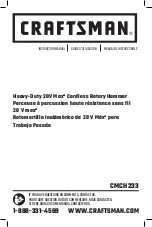
3
• When battery pack is not in use, keep it away
from other metal objects, like paper clips, coins,
keys, nails, screws or other small metal objects,
that can make a connection from one terminal
to another.
Shorting the battery terminals together
may cause burns or a fire.
• Under abusive conditions, liquid may be ejected
from the battery; avoid contact. If contact acci
-
dentally occurs, flush with water. If liquid con
-
tacts eyes, additionally seek medical help.
Liquid
ejected from the battery may cause irritation or burns.
• Do not use a battery pack or tool that is dam
-
aged or modified.
Damaged or modified batteries
may exhibit unpredictable behavior resulting in fire,
explosion or risk of injury.
• Do not expose a battery pack or tool to fire or
excessive temperature.
Exposure to fire or tem
-
perature above
130
°
C
(
265
°
F
) may cause explosion.
• Follow all charging instructions and do not
charge the battery pack or tool outside the
temperature range specified in the instructions.
Charging improperly or at temperatures outside
the specified range may damage the battery and
increase the risk of fire.
SERVICE
• Have your power tool serviced by a qualified
repair person using only identical replacement
parts.
This will ensure that the safety of the power
tool is maintained.
• Never service damaged battery packs.
Service
of battery packs should only be performed by the
manufacturer or authorized service providers.
SPECIFIC SAFETY RULES FOR
ROTARY HAMMERS
• Wear ear protectors.
Exposure to noise can cause
hearing loss.
• Use auxiliary handle(s), if supplied with the tool.
Loss of control can cause personal injury.
• Hold power tools by insulated gripping surfaces,
when performing an operation where the cutting
tool may contact hidden wiring.
Cutting accessory
contacting a “live” wire may make exposed metal
parts of the power tool “live” and could give the
operator an electric shock.
• Keep hands away from all cutting edges and
moving parts.
•
Maintain labels and nameplates.
These carry
important information. If unreadable or missing,
contact a
MILWAUKEE
®
service
facility
for
a
replacement.
•
WARNING
Some dust created by power sand-
ing, sawing, grinding, drilling, and
other construction activities contains chemicals
known to cause cancer, birth defects or other repro-
ductive harm. Some examples of these chemicals
are:
• lead from lead-based paint
• crystalline silica from bricks and cement and other
masonry products, and
• arsenic and chromium from chemically-treated
lumber.
Your risk from these exposures varies, depending
on how often you do this type of work. To reduce
your exposure to these chemicals: work in a well
ventilated area, and work with approved safety
equipment, such as those dust masks that are spe-
cially designed to filter out microscopic particles.
SYMBOLOGY
Volts
Direct Current
No-Load Revolutions per Minute (RPM)
BPM
Blows per Minute (BPM)
SPECIFICATIONS
Cat. No. .............................................
.. M18
CHD-0
Volts
..............................................................
18 DC
Battery Type
.................................................
M18™
Charger Type
................................................
M18™
No Load RPM
............................................
0 - 1400
BPM
...........................................................
0 - 4900
Type
.........................................................
SDS Plus
Twist bit
..................................................
25 mm (1
"
)
Core bit
..............................................
63 mm
(
2.5"
)
FUNCTIONAL DESCRIPTION
1. Bit holder
2. Bit release collar
3. Side handle
4. Mode selector knob
5. LED
6. Trigger handle
7. Trigger
8. Control switch
9. Clamping lever
10.
Depth gauge rod
4
2
6
7
8
1
3
9
5
10
Summary of Contents for M18 CHD-0
Page 7: ......


















